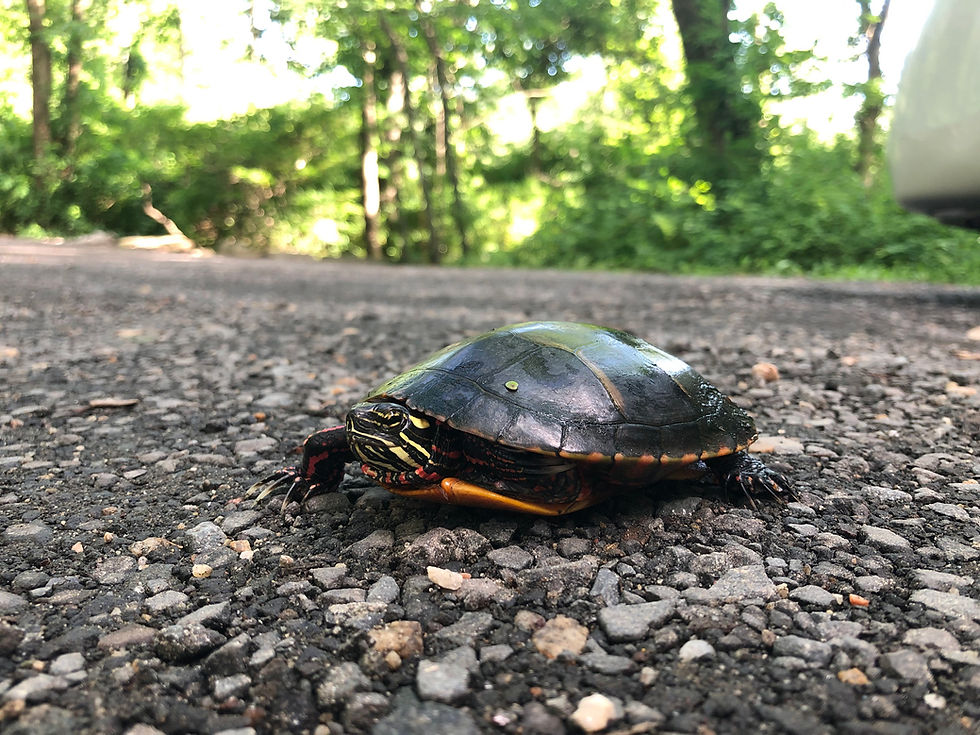Notes from a Naturalist

October 23, 2025
By Jen Meikle - Environmental Educator
During fall, one of our afterschool activities is handing each child a basket and telling them that we’re going on a hunt to collect acorns. The kids always have such a great time searching the ground and filling their baskets; excitedly exclaiming and showing us how many they have found, the biggest and smallest ones, the special ones that are joined onto others, and so on. Once the acorn hunt is finished, they often beg to do it again and again, even when we have moved on to other interesting topics and activities!
- Read the full article here

September 27, 2025
The Devil's Advocate of Poison Ivy
By Kevin Andros - Environmental Educator
Poison Ivy isn’t evil. I know, I know, that’s a controversial statement. It’s like saying mosquitos are good to have around (which is a Naturalist Note for another day). I want to be clear that I’m not saying this from the sidelines, I’ve had displeasurable encounters with poison ivy a handful of times. The culprit of itchy rashes is an oil called urushiol that is found in the leaves, stem, and roots of poison ivy, oak, and sumac. Nevertheless, poison ivy has an incredibly interesting history, has evolved to produce urushiol for good reason, and is beneficial to its ecosystem.
- Read the full article here

June 6, 2025
Shedding Light on Nocturnal Insects
By Tommy McCarthy - Environmental Educator
With the lush green days of summer being nearly upon us, the life cycles of countless insects have been resuming! Different species have overwintered in different ways - some as eggs, some as larvae, and some as adults. Some, like monarch butterflies, have even made migratory journeys. In the United States, there are around 91,000 insect species that humans have discovered and named. On top of that huge number, scientists estimate that there are another 73,000 or so that have not yet been described - which might surprise you since we tend to think mostly of the oceans when it comes to undiscovered life on our planet.
- Read the full article here

April 28, 2025
Native Plant Spotlight: Trout Lily
By Jen Meikle - Environmental Educator
Having native plants in our local ecosystems has many benefits, other than just looking beautiful. Native plants have grown in that area naturally for thousands of years, without human introduction. Over time, their DNA has evolved to be best suited to the conditions of their environment. They are adjusted to the climate, soil, and the wildlife of the area, making them very resilient. Many have formed symbiotic relationships with other species, offering the best food and habitat to support local wildlife and encouraging biodiversity.
- Read the full article here

March 19, 2025
By Kevin Andros - Environmental Educator
The title is a bit of an exaggeration but I wanted to hook you in to share a really cool group of plants that most people don’t even know exists. Clubmosses are an order of plants within the class Lycopods. Lycopods are the oldest surviving vascular plants which means they are some of the earliest plants that have specialized tissue to transfer water and nutrients throughout the plant. Some of the extinct species, during the carboniferous period, towered over rainforests at more than 100 feet tall. Now that we have the basics out of the way we can move on to the explosions.
- Read the full article here
.jpg)
February 26, 2025
Seeking Out Seasonal Change: The Magic of Phenology
By Tommy McCarthy - Environmental Educator
“Phenology” is a word that I had first heard of from signs alongside trails at nature preserves. It’s not one of the more well known “ologies” that we usually think of when it comes to nature, like ecology, biology and geology. Even ones like entomology (the study of insects) and ornithology (the study of birds) are typically more well recognized. But phenology is something we all think about and take note of each year whether or not we realize it, and now is the perfect time to become more aware of it.
- Read the full article here

January 14, 2025
How Do Trees Survive the Winter?
By Jen Meikle - Environmental Educator
Winter is a time for rest and hibernation. The shorter daylight hours and cold temperatures tend to make humans want to cozy up inside and bide our time until spring. This time of year, most animals are doing the same. While trees are rooted in the ground and can’t take refuge until the cold winter months are over like humans and animals do, they have adapted their own protections against the harsh winter elements.
- Read the full article here





